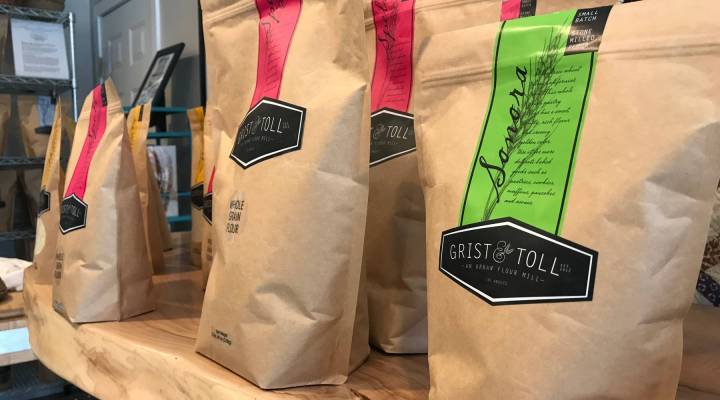
Grist & Toll flour mill wants to change your bread

Hidden in a slightly industrial-looking strip mall in the middle of Pasadena, California, is a flour mill. It’s called Grist & Toll, and Nan Kohler is the owner and miller. At the mill, Kohler explained how just a few hundred years ago, flour mills used to be the city centers, but now mills like her’s in an urban center are unheard of.
After showing us around the facility, Kohler explained why our culture traded in whole wheat flour for the white, highly processed stuff we see on the grocery shelves today.
Nan Kohler: As long as there’s been wheat, and milling, and baking, there’s been a desire to have white refined flour. White flour, white bread, has symbolized so much in our history: class, wealth, status, politics, religion. We are very tied to white bread and white refined flour.
Kai Ryssdal: There’s an entrepreneurship question to ask here: How long you been up and running?
Kohler: It will be four years this holiday season.
Ryssdal: You bootstrap yourself on credit cards, or how do you wind up getting started?
Kohler: No, I had a small amount of money to invest, and then absolutely credit card debt, and then a small business association loan. I’ve learned a lot. Now, I would do things very differently if I was starting all over again.
Ryssdal: Are you profitable?
Kohler: Yes. I think the critical thing that I have been able to show, because I literally am the only business model like this as far as I know in the United States — there are definitely independent stone mills popping up in other regions, I know of five or six of them, but that’s it — but I’m the only one that went for it, dropped itself in the middle of a very urban big city, and with direct access to all customers, both chefs and professional bakers, so the wholesale level, but our local home baking community, which has been incredibly supportive. I absolutely had obstacles in the beginning with getting up and running and getting all of my permits in line, and it’s the home bakers that paid my rent and kept the lights on.
Ryssdal: So there’s a lot that goes on with wheat nowadays, right? Gluten-free is one of them. There’s a whole bunch of other stuff. How big an issue is that for you as a business person?
Kohler: I probably was a little crazy to launch a wheat-centered business in the middle of the biggest gluten-hating period in our lives. But the truth of the matter is milling absolutely matters. I have so many customers who come in weekly who say, “I had cut wheat out of my life, I was no longer eating bread and you have changed everything for me and now I don’t have the same issues that I had before.” Celiac disease, obviously something very different. They can’t even walk into this place.
Ryssdal: With quality and with all of these things that you value in this bread, it ain’t cheap.
Kohler: It’s not cheap, and definitely important parts of the conversation have to do with that transparency and what I would call real wheat pricing. We have tremendous opportunity in California. We grow beautiful wheat. Because of our amazing climate, we can do fall plantings, we can also do spring planting, so we have much more flexibility with when we can put the grain in the ground. That’s great for farmers and how they manage their rotations. We also have some of the most expensive land in all of the United States. That’s why we grow beautiful wheat, but it’s been dropping, the amounts overall, because it’s much more profitable for the farmers to put more expensive vegetables, higher cash value crops, on that same land. When wheat milling left the city centers, everything that supported that also left. So the other bigger part of the conversation with pricing and why I’m an expensive part of this equation — but I would argue a very necessary part of this equation — is even for farmers who plant 5 to 10 acres for me, having the right seed drills, having the right combines that can come and harvest — all of those got junked, and so now they’re piecing together that. The smaller-scale seed-cleaning facilities that handled wheat: gone. Their minimum batch sizes are pretty huge. So it is really a big thing to try and put all of these things in place. And at the beginning, it’s never inexpensive.
| Becoming a food and wine “superhero” |
| Oregon company makes a point of hiring ex-convicts |
There’s a lot happening in the world. Through it all, Marketplace is here for you.
You rely on Marketplace to break down the world’s events and tell you how it affects you in a fact-based, approachable way. We rely on your financial support to keep making that possible.
Your donation today powers the independent journalism that you rely on. For just $5/month, you can help sustain Marketplace so we can keep reporting on the things that matter to you.












